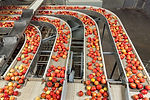Tray Sealers
About tray sealers
A tray sealer is used to seal food products in trays, extending their shelf life and maintaining product quality. Choosing the right one can be a challenge especially if you are just starting out in the food processing and packing business. Here are some of the key factors to consider when selecting a tray sealer for your business.
Different types of tray sealers
Before you start the selection process, let's look at the primary types of tray sealers.
-
Impulse Sealers - Use heat to melt a sealing film, creating a strong, airtight seal. They are ideal for small-scale operations and are relatively affordable.
-
Continuous Motion Sealers - Designed for high-volume production, these sealers continuously feed trays through a sealing station, offering high efficiency.
-
Vacuum Sealers - These sealers remove air from the tray before sealing, extending the shelf life of perishable products.
-
Gas Flush Sealers - These sealers replace air with a gas mixture (often nitrogen or carbon dioxide) to create a modified atmosphere, preserving food quality.

Key factors to consider when selecting a tray sealer
-
Production Volume:
-
Small-scale operations - An impulse sealer is often sufficient.
-
Medium-scale operations - A continuous motion sealer can handle moderate volumes efficiently.
-
Large-scale operations - A high-speed continuous motion sealer or a vacuum/gas flush sealer is more likely the best option.
-
-
Product Type:
-
Solid products - A standard impulse or continuous motion sealer should be s suitable.
-
Liquid or semi-liquid products: A vacuum or gas flush sealer will better prevent leakage.
-
-
Packaging Material:
-
Ensure the sealer is compatible with the types of trays and films you plan to use.
-
Consider the thickness and material of the film, as it will impact sealing time and temperature.
-
-
Sealing Speed:
-
A high-speed sealer is essential if you are looking for high-volume production.
-
A slower sealer may be sufficient for smaller operations or products that require more delicate handling.
-

Key questions to ask when looking for a used tray sealer
If you are looking for a used tray sealer then here are some questions that will help you find the right machine for you.
Production requirements
What is your estimated production volume (trays per minute/hour/day)?
This helps determine the necessary speed and automation level.
What types of trays will you be using (materials, sizes, depths)?
Ensure compatibility with the machine's tooling and capabilities.
What types of films will you be using (materials, thicknesses)?
Confirm the machine can handle your desired packaging materials.
Will you need modified atmosphere packaging (MAP) capabilities (gas flush, vacuum)?
This is crucial for extending shelf life, especially for fresh produce and ready meals.
Machine Specifications
What is the machine's cycle speed and sealing time?
Balance speed with the needs of your product and desired output.
What is the maximum tray size the machine can accommodate?
Ensure it can handle your current and potential future needs.
What level of automation does the machine offer (manual, semi-automatic, fully automatic)?
Consider your budget and labour resources.
Technical Aspects
What is the machine's power supply requirements (voltage, phase, amperage)?
Ensure compatibility with your facility's electrical system.
What are the machine's dimensions and weight?
Confirm it will fit in your workspace and that you have the means to move and install it.
What is the machine's construction material (stainless steel, etc.)?
Consider hygiene and durability, especially in demanding environments.

























